SNAS362G May 2006 – April 2016 DAC104S085 , DAC104S085-Q1
PRODUCTION DATA.
- 1 Features
- 2 Applications
- 3 Description
- 4 Revision History
- 5 Description (continued)
- 6 Pin Configuration and Functions
- 7 Specifications
- 8 Detailed Description
- 9 Application and Implementation
- 10Power Supply Recommendations
- 11Layout
- 12Device and Documentation Support
- 13Mechanical, Packaging, and Orderable Information
9 Application and Implementation
NOTE
Information in the following applications sections is not part of the TI component specification, and TI does not warrant its accuracy or completeness. TI’s customers are responsible for determining suitability of components for their purposes. Customers should validate and test their design implementation to confirm system functionality.
9.1 Application Information
While the simplicity of the DAC104S085 implies ease of use, it is important to recognize that the path from the reference input (VREFIN) to the VOUTs has essentially zero Power Supply Rejection Ratio (PSRR). Therefore, it is necessary to provide a noise-free supply voltage to VREFIN. To use the full dynamic range of the DAC104S085, the supply pin (VA) and VREFIN can be connected together and share the same supply voltage. Because the DAC104S085 consumes very little power, a reference source may be used as the reference input and/or the supply voltage. The advantages of using a reference source over a voltage regulator are accuracy and stability. Some low noise regulators can also be used. Listed below are a few reference and power-supply options for the DAC104S085.
9.1.1 LM4130
The LM4130, with its 0.05% accuracy over temperature, is a good choice as a reference source for the DAC104S085. The 4.096-V version is useful if a 0 to 4.095-V output range is desirable or acceptable. Bypassing the LM4130 VIN pin with a 0.1-µF capacitor and the VOUT pin with a 2.2-µF capacitor improves stability and reduces output noise. The LM4130 comes in a space-saving, 5-pin SOT-23.
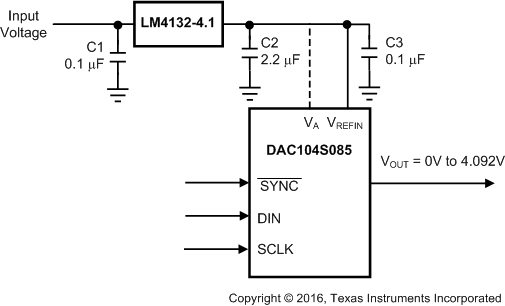 Figure 33. LM4130 as a Power Supply
Figure 33. LM4130 as a Power Supply
9.1.2 LP3985
The LP3985 is a low-noise, ultra-low dropout voltage regulator with a 3% accuracy over temperature. It is a good choice for applications that do not require a precision reference for the DAC104S085. It comes in 3-V, 3.3-V, and 5-V versions, among others, and sports a low 30-µV noise specification at low frequencies. Because low-frequency noise is relatively difficult to filter, this specification could be important for some applications. The LP3985 device comes in a space-saving, 5-pin SOT-23 and 5-bump DSBGA packages.
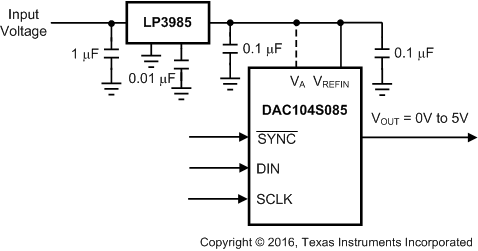 Figure 34. Using the LP3985 Regulator
Figure 34. Using the LP3985 Regulator
An input capacitance of 1-µF without any ESR requirement is required at the LP3985 input, while a 1-µF ceramic capacitor with an ESR requirement of 5 mΩ to 500 mΩ is required at the output. Careful interpretation and understanding of the capacitor specification is required to ensure correct device operation.
9.1.3 LP2980
The LP2980 is an ultra-low dropout regulator with a 0.5% or 1% accuracy over temperature, depending upon grade. It is available in 3-V, 3.3-V, and 5-V versions, among others.
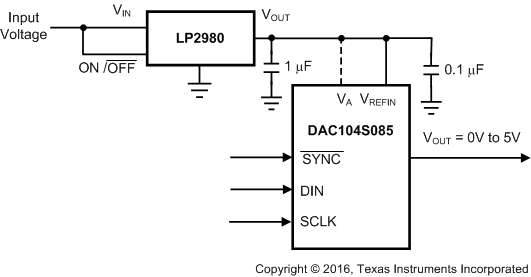 Figure 35. Using the LP2980 Regulator
Figure 35. Using the LP2980 Regulator
Like any low dropout regulator, the LP2980 requires an output capacitor for loop stability. This output capacitor must be at least 1 µF over temperature, but values of 2.2 µF or more provides even better performance. The ESR of this capacitor should be within the range specified in the LP2980 data sheet (SNOS733). Surface-mount solid tantalum capacitors offer a good combination of small size and ESR. Ceramic capacitors are attractive due to their small size, but, generally have ESR values that are too low for use with the LP2980. Aluminum electrolytic capacitors are typically not a good choice due to their large size and have ESR values that may be too high at low temperatures.
9.2 Typical Application
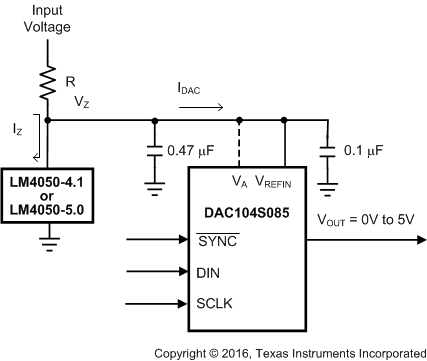 Figure 36. The LM4050 as a Power Supply
Figure 36. The LM4050 as a Power Supply
9.2.1 Design Requirements
While the simplicity of the DAC104S085 implies ease of use, it is important to recognize that the path from the reference input (VREFIN) to the VOUTs has essentially zero Power Supply Rejection Ratio (PSRR). Therefore, it is necessary to provide a noise-free supply voltage to VREFIN. To use the full dynamic range of the DAC104S085, the supply pin (VA) and VREFIN can be connected together and share the same supply voltage. Figure 36 uses an LM4050 as a voltage reference source for the DAC104S085.
9.2.2 Detailed Design Procedure
Available with accuracy of 0.44%, the LM4050 shunt reference is also a good choice as a reference for the DAC104S085. It is available in 4.096-V and 5-V versions and comes in a space-saving, 3-pin SOT-23.
The minimum resistor value in the circuit of Figure 36 must be chosen so that the maximum current through the LM4050 does not exceed its 15-mA rating. The conditions for maximum current include the input voltage at its maximum, the LM4050 voltage at its minimum, and the DAC104S085 drawing zero current. The maximum resistor value must allow the LM4050 to draw more than its minimum current for regulation plus the maximum DAC104S085 current in full operation. The conditions for minimum current include the input voltage at its minimum, the LM4050 voltage at its maximum, the resistor value at its maximum due to tolerance, and the DAC104S085 draws its maximum current. Equation 4 and Equation 5 summerize these conditions.
and
where
- VZ(min) and VZ(max) are the nominal LM4050 output voltages ± the LM4050 output tolerance over temperature
- IZ(max) is the maximum allowable current through the LM4050
- IZ(min) is the minimum current required by the LM4050 for proper regulation
- IDAC(max) is the maximum DAC104S085 supply current.
9.2.3 Application Curves
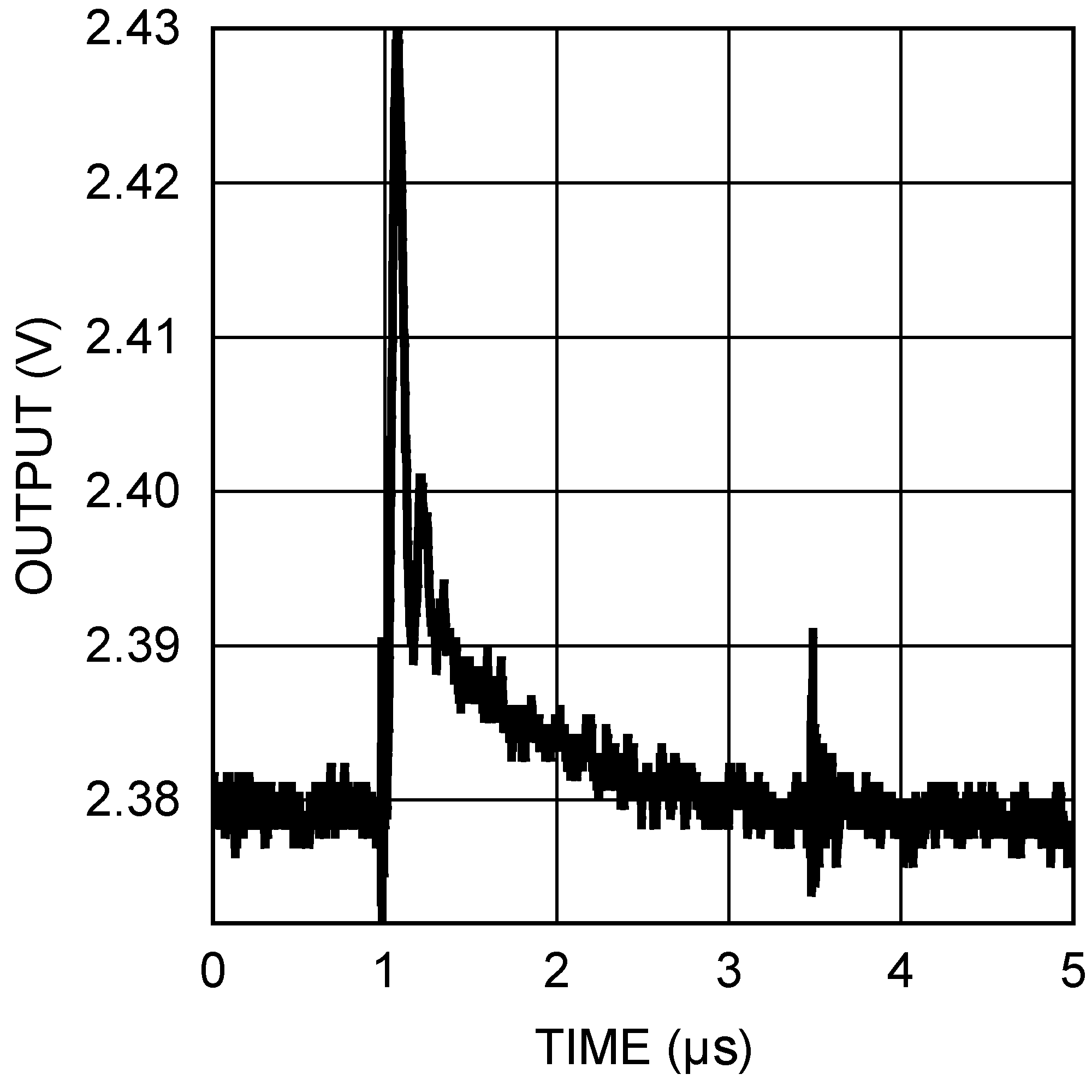 Figure 37. 5-V Glitch Response
Figure 37. 5-V Glitch Response
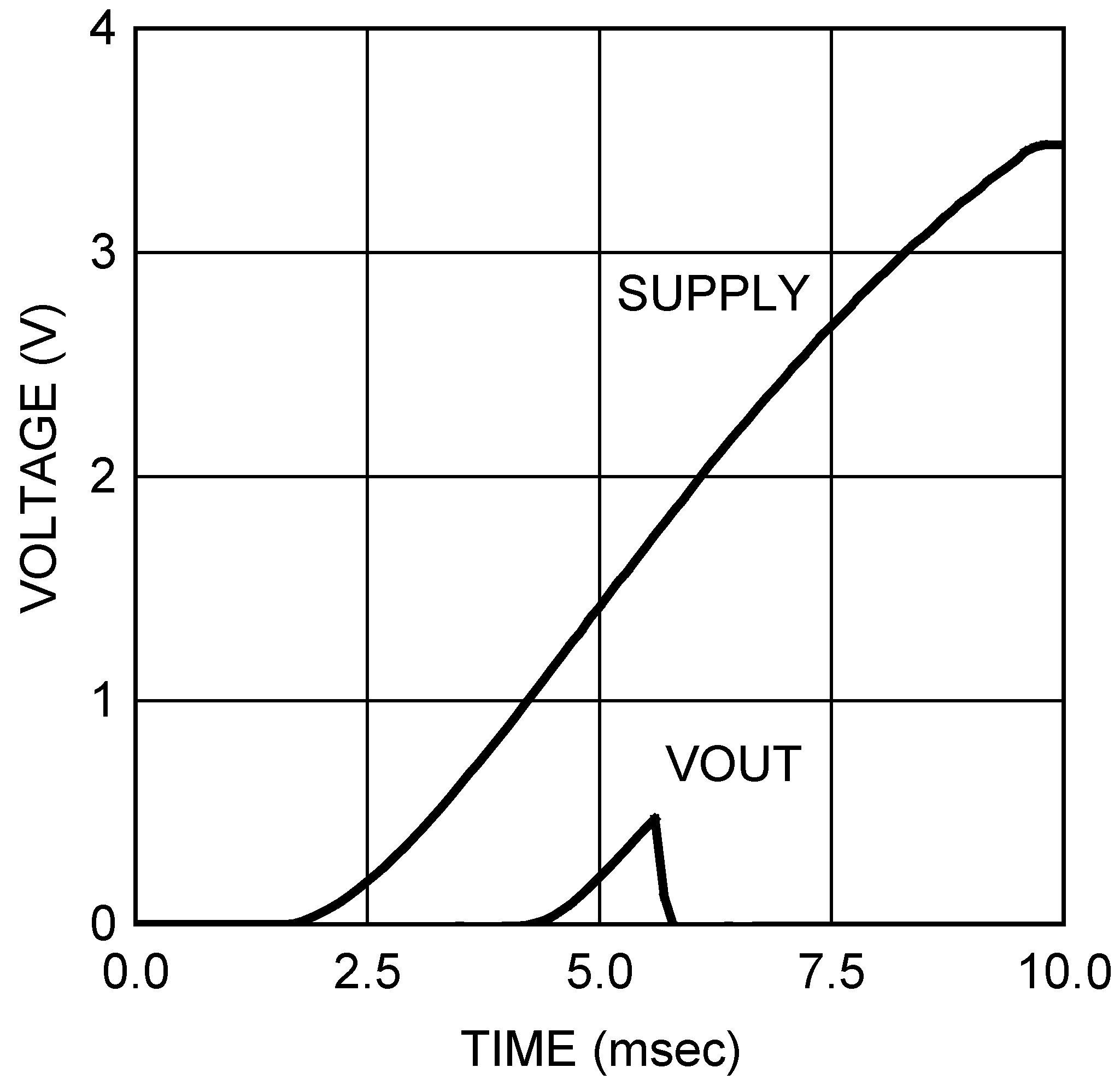 Figure 38. Power-On Reset
Figure 38. Power-On Reset